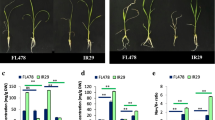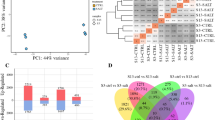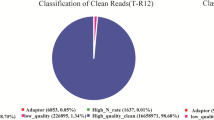Abstract
Salinity tolerance has been documented as one of the main abiotic stresses, disapprovingly impeding the growth and fertility of core food crops including rice in the ecosphere. We have evaluated 24 varieties exposed to salt stress (150–300 mM NaCl; for 48–72 h) at the vegetative stage. The cellular-level physiological response was observed by assessing the morphophysiological parameters and significant differences were observed in the rice varieties of the Gujarat region of the Indian continent. Additionally, we have performed a comparative transcriptome analysis of the shoots and roots of rice varieties at the vegetative stage (Dandi, salinity-tolerant; and GR-11, Salinity-sensitive) in response to salinity. Based on transcriptome analysis, the genes specifically activated and differentially over-expressed during salinity stress belong to different functional categories mostly located on chromosomes 1, 2, 3, 4, 8, and 11 in both cultivars. A total of 617 and 676 significant DEGs with log2-fold change in the range of ≥ + 2.0 to ≤ − 2.0 were identified from the comparative analysis of the two data sets DS (Dandi Shoot) and GS (GR-11Shoot) (Dandi vs. Control, GR-11 vs. Control) in the shoot sample. Similarly, a total of 510 and 508 significant DEGs DR (Dandi Root) and GR (GR-11 Root) (Dandi vs. Control, GR-11 vs. Control) in the root samples. The DEGs were examined against the KEGG database to explore the biological pathways of Dandi (226) and GR-11 (397) in the shoot as well as root (218,285) samples. Further PageMan analysis showed that there was a significantly higher number of DEGs (p < 0.05, ≥ ± 2.0-fold) involved in signalling pathways including secondary metabolism, hormone metabolism, abiotic stresses, and development which have significant regulatory functions in shoot and root of Dandi and GR-11 variety of rice.




Similar content being viewed by others
Data availability
All the supplementary data is available in the supplementary data section. The raw data supporting the conclusions of this article will be made available by the authors, without undue reservation.
References
Ahmad M, Nangyal H, Imran M, Ullah F (2016) Optimization of protocol for surface sterilization and callus induction for three rice varieties. J Am-Eurasian J Agric Environ Sci 16(2):357–361
Anders S, Huber WJNP (2010) Differential expression analysis for sequence count data. In: J Nature Precedings. pp 1–1
Andrews S, Krueger F, Segonds-Pichon A, Biggins L, Krueger C, Wingett S (2010) FastQC
Asch F, Dingkuhn M, Dörffling K, Miezan K (2000) Leaf K/Na ratio predicts salinity induced yield loss in irrigated rice. Euphytica 113(2):109–118
Askari H, Kazemitabar SK, Zarrini HN, Saberi MH (2016) Salt tolerance assessment of barley (Hordeum vulgare L.) genotypes at germination stage by tolerance indices. Open Agric 1(1):37–44
Assaha DV, Ueda A, Saneoka H, Al-Yahyai R, Yaish MW (2017) The role of Na+ and K+ transporters in salt stress adaptation in glycophytes. Front Physiol 8:509
Bolger AM, Lohse M, Usadel B (2014) Trimmomatic: a flexible trimmer for Illumina sequence data. Bioinformatics 30(15):2114–2120
Brutus A, Sicilia F, Macone A, Cervone F, De Lorenzo G (2010) A domain swap approach reveals a role of the plant wall-associated kinase 1 (WAK1) as a receptor of oligogalacturonides. Proc Natl Acad Sci 107(20):9452–9457
Challabathula D, Analin B, Mohanan A, Bakka K (2022) Differential modulation of photosynthesis, ROS and antioxidant enzyme activities in stress-sensitive and-tolerant rice cultivars during salinity and drought upon restriction of COX and AOX pathways of mitochondrial oxidative electron transport. J Plant Physiol 268:153583
del Río LA, Sandalio LM, Corpas FJ, Palma JM, Barroso JB (2006) Reactive oxygen species and reactive nitrogen species in peroxisomes. Production, scavenging, and role in cell signaling. Plant Physiol 141(2):330–335
Fernández-Varea J, Mayol R, Liljequist D, Salvat F (1993) Inelastic scattering of electrons in solids from a generalized oscillator strength model using optical and photoelectric data. J Phys Condens Matter 5(22):3593
Formentin E, Sudiro C, Perin G, Riccadonna S, Barizza E, Baldoni E, Lavezzo E, Stevanato P, Sacchi GA, Fontana P (2018) Transcriptome and cell physiological analyses in different rice cultivars provide new insights into adaptive and salinity stress responses. Front Plant Sci 9:204
Ganie SA, Borgohain MJ, Kritika K, Talukdar A, Pani DR, Mondal TK (2016) Assessment of genetic diversity of Saltol QTL among the rice (Oryza sativa L.) genotypes. Physiol Mol Biol Plants 22(1):107–114
Ganie SA, Wani SH, Henry R, Hensel G (2021) Improving rice salt tolerance by precision breeding in a new era. Curr Opin Plant Biol 60:101996
Garg R, Verma M, Agrawal S, Shankar R, Majee M, Jain M (2014) Deep transcriptome sequencing of wild halophyte rice, Porteresia coarctata, provides novel insights into the salinity and submergence tolerance factors. DNA Res 21(1):69–84
Garg R, Bhattacharjee A, Jain M (2015) Genome-scale transcriptomic insights into molecular aspects of abiotic stress responses in chickpea. Plant Mol Biol Rep 33(3):388–400
Grant MR, Jones JD (2009) Hormone (dis) harmony molds plant health and disease. Science 324(5928):750–752
Grattan S, Zeng L, Shannon M, Roberts S (2002) Rice is more sensitive to salinity than previously thought. J Calif Agric 56(6):189–198
Hanin M, Ebel C, Ngom M, Laplaze L, Masmoudi K (2016) New insights on plant salt tolerance mechanisms and their potential use for breeding. Front Plant Sci 7:1787
Higbie SM, Wang F, Stewart JM, Sterling TM, Lindemann WC, Hughs E, Zhang JJIJoA (2010) Physiological response to salt (NaCl) stress in selected cultivated tetraploid cotton
Hu S, Ding Y, Zhu C (2020) Sensitivity and responses of chloroplasts to heat stress in plants. Front Plant Sci 11:375
Ibrahim W, Qiu CW, Zhang C, Cao F, Shuijin Z, Wu F (2019) Comparative physiological analysis in the tolerance to salinity and drought individual and combination in two cotton genotypes with contrasting salt tolerance. Physiol Plant 165(2):155–168
International Rice Research Institute (1967) Screening rice for salinity tolerance An Annual report for 1967, Manila (Philippines), pp 308
Ismail AM, Horie T (2017) Genomics, physiology, and molecular breeding approaches for improving salt tolerance. Annu Rev Plant Biol 68:405–434
Kazemi K, Eskandari H (2011) Effects of salt stress on germination and early seedling growth of rice (Oryza sativa) cultivars in Iran. Afr J Biotech 10(77):17789–17792
Khan MIR, Palakolanu SR, Chopra P, Rajurkar AB, Gupta R, Iqbal N, Maheshwari C (2021) Improving drought tolerance in rice: ensuring food security through multi-dimensional approaches. Physiol Plant 172(2):645–668
Kim D, Langmead B, Salzberg SL (2015) HISAT: a fast spliced aligner with low memory requirements. Nat Methods 12(4):357–360
Kong W, Zhong H, Gong Z, Fang X, Sun T, Deng X, Li Y (2019) Meta-analysis of salt stress transcriptome responses in different rice genotypes at the seedling stage. Plants 8(3):64
Kong W, Zhang C, Qiang Y, Zhong H, Zhao G, Li Y (2020) Integrated RNA-Seq analysis and Meta-QTLs mapping provide insights into cold stress response in rice seedling roots. Int J Mol Sci 21(13):4615
Kong W, Zhang C, Zhang S, Qiang Y, Zhang Y, Zhong H, Li Y (2021b) Uncovering the novel QTLs and candidate genes of salt tolerance in rice with linkage mapping, RTM-GWAS, and RNA-seq. Rice 14(1):1–12
Kong W, Sun T, Zhang C, Deng X, Li Y (2021a) Comparative transcriptome analysis reveals the mechanisms underlying differences in salt tolerance between indica and japonica rice at seedling stage. Front Plant Sci 12
Kumar A, Bernier J, Verulkar S, Lafitte H, Atlin G (2008) Breeding for drought tolerance: direct selection for yield, response to selection and use of drought-tolerant donors in upland and lowland-adapted populations. Field Crop Res 107(3):221–231
Le Gall H, Philippe F, Domon J-M, Gillet F, Pelloux J, Rayon C (2015) Cell wall metabolism in response to abiotic stress. Plants 4(1):112–166
Lenka SK, Katiyar A, Chinnusamy V, Bansal KC (2011) Comparative analysis of drought-responsive transcriptome in Indica rice genotypes with contrasting drought tolerance. Plant Biotechnol J 9(3):315–327
Ma Y, Dias MC, Freitas H (2020) Drought, and salinity stress responses and microbe-induced tolerance in plants. Front Plant Sci 11:1750
Mahmud S, Sharmin S, Chowdhury BLD, Hossain MA, Bhuiyan MJH (2016) Mitigation of salt stress in rice plant at germination stage by using methyl jasmonate. Asian J Med Biol Res 2(1):74–81
MirdarMansuri R, Shobbar Z-S, BabaeianJelodar N, Ghaffari M, Mohammadi SM, Daryani P (2020) Salt tolerance involved candidate genes in rice: an integrative meta-analysis approach. BMC Plant Biol 20(1):1–14
Munawar W, Hameed A, Khan MKR (2021) Differential morphophysiological and biochemical responses of cotton genotypes under various salinity stress levels during early growth stage. J Front Plant Sci 12:335
Nakabayashi R, Yonekura-Sakakibara K, Urano K, Suzuki M, Yamada Y, Nishizawa T, Matsuda F, Kojima M, Sakakibara H, Shinozaki K (2014) Enhancement of oxidative and drought tolerance in Arabidopsis by overaccumulation of antioxidant flavonoids. Plant J 77(3):367–379
Pertea M, Pertea GM, Antonescu CM, Chang T-C, Mendell JT, Salzberg SL (2015) StringTie enables improved reconstruction of a transcriptome from RNA-seq reads. Nat Biotechnol 33(3):290–295
Pires IS, Negrão S, Oliveira MM, Purugganan MD (2015) Comprehensive phenotypic analysis of rice (Oryza sativa) response to salinity stress. Physiol Plant 155(1):43–54
Razzaque S, Sabrina M. E, Taslima H, Sudip B, Nurnabi A., Sazzadur R., Xiaoyu W., Abdelbagi M. l, Harkamal W., Thomas E. J. and Zeba I. S (2019). Gene Expression analysis associated with salt stress in a reciprocally crossed rice population. Sci Rep 8249(9):10–24. https://doi.org/10.1038/s41598-019-44757-4
Reddy DS, Bhatnagar-Mathur P, Reddy PS, Sri Cindhuri K, Sivaji Ganesh A, Sharma KK (2016) Identification and validation of reference genes and their impact on normalized gene expression studies across cultivated and wild cicer species. PLoS ONE 11(2):e0148451
Roy SJ, Negrão S, Tester M (2014) Salt resistant crop plants. Curr Opin Biotechnol 26:115–124
Shankar R, Bhattacharjee A, Jain M (2016) Transcriptome analysis in different rice cultivars provides novel insights into desiccation and salinity stress responses. Sci Rep 6(1):1–15
Shepherd T, Griffiths W (2006) The effects of stress on plant cuticular waxes. New Phytol 171(3):469–499
Shereen A, Mumtaz S, Raza S, Khan M, Solangi S (2005) Salinity effects on seedling growth and yield components of different inbred rice lines. J Pak J Bot 37(1):131–139
Tenhaken R (2015) Cell wall remodeling under abiotic stress. Front Plant Sci 5:771
Tian T, Liu Y, Yan H, You Q, Yi X, Du Z, Xu W, Su Z (2017) a GO analysis toolkit for the agricultural community, 2017 update. Nucleic Acids Res 45(W1):W122–W129
Trapnell C, Williams BA, Pertea G, Mortazavi A, Kwan G, Van Baren MJ, Salzberg SL, Wold BJ, Pachter L (2010) Transcript assembly and quantification by RNA-Seq reveals unannotated transcripts and isoform switching during cell differentiation. Nat Biotechnol 28(5):511–515
Verma G, Srivastava D, Tiwari P, Chakrabarty (2019) ROS modulation in crop plants under drought stress. Genetics 311–336
Walia H, Wilson C, Condamine P, Liu X, Ismail AM, Zeng L, Close TJ (2005) Comparative transcriptional profiling of two contrasting rice genotypes under salinity stress during the vegetative growth stage. Plant Physiol 139(2):822–835
Wang S, Blumwald E (2014) Stress-induced chloroplast degradation in Arabidopsis is regulated via a process independent of autophagy and senescence-associated vacuoles. Plant Cell 26(12):4875–4888
Yu X, Liu H, Hamel KA, Morvan MG, Yu S, Leff J, Guan Z, Braz JM, Basbaum AI (2020) Dorsal root ganglion macrophages contribute to both the initiation and persistence of neuropathic pain. J Nat Commun 11(1):1–12
Zeng L, Shannon MC (2000) Salinity effects on seedling growth and yield components of rice. J Crop Sci 40(4):996–1003
Zhou M, Li D, Li Z, Hu Q, Yang C, Zhu L, Luo H (2013) Constitutive expression of a miR319 gene alters plant development and enhances salt and drought tolerance in transgenic creeping bentgrass. J Plant Physiol 161(3):1375–1391
Acknowledgements
Authors are thankful to The Department of Agri. Biotechnology, Anand Agriculture University, Anand, Gujarat (India) for providing the experimental facility.
Funding
No potential funding is involved to carry out this study.
Author information
Authors and Affiliations
Contributions
A.V. did the overall execution of the experiment, analytical work, and collection of data after morpho-physiological and biochemical analysis of leaves, organization of resulting data, and writing up and revision of the manuscript. Y.D. and N.B. contributed to the planning, designing, and finalization of the basic idea of the experiment and overall supervision during analytical work carried out the statistical analysis of data using XL-STAT software did the presentation of the resulting data in the form of graphs, and revised and finalized the manuscript. R.T., C.J., and S.N. the arrangement and provision of rice seeds contributed to the study's basic idea and planning of the glasshouse experiment and revised and finalized the manuscript. All authors contributed to the article and approved the submitted version.
Corresponding author
Ethics declarations
Conflict of interest
The authors have no relevant financial or non-financial interests to disclose.
Additional information
Communicated by Tommaso Martinelli.
Supplementary Information
Below is the link to the electronic supplementary material.
Rights and permissions
Springer Nature or its licensor (e.g. a society or other partner) holds exclusive rights to this article under a publishing agreement with the author(s) or other rightsholder(s); author self-archiving of the accepted manuscript version of this article is solely governed by the terms of such publishing agreement and applicable law.
About this article
Cite this article
Vala, A.K.G., Bano, N., Deshmukh, Y. et al. Transcriptome analysis identifies novel gene(s) and pathways for salt stress responses in Dandi cultivar. CEREAL RESEARCH COMMUNICATIONS 51, 351–365 (2023). https://doi.org/10.1007/s42976-022-00319-5
Received:
Accepted:
Published:
Issue Date:
DOI: https://doi.org/10.1007/s42976-022-00319-5




